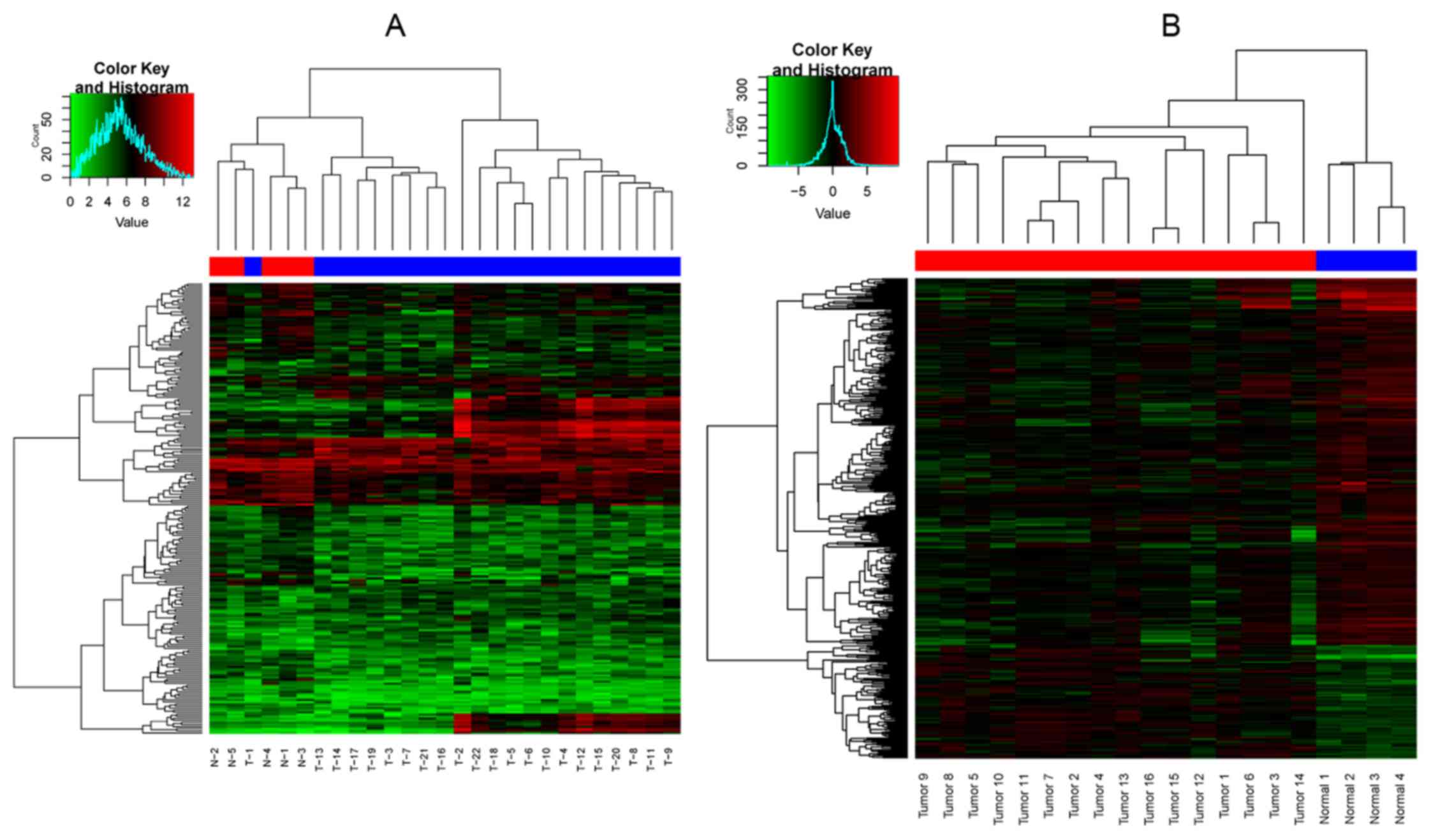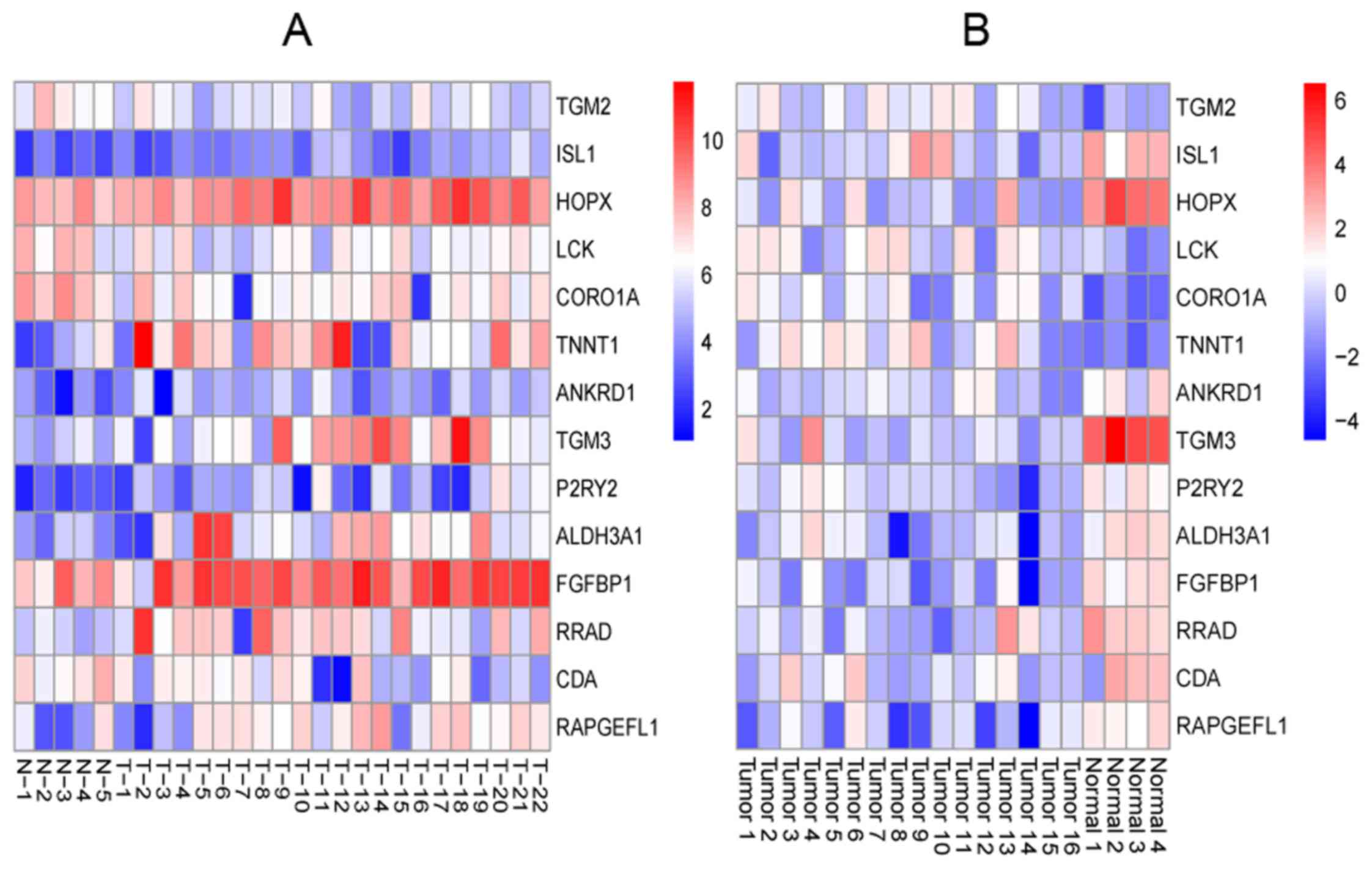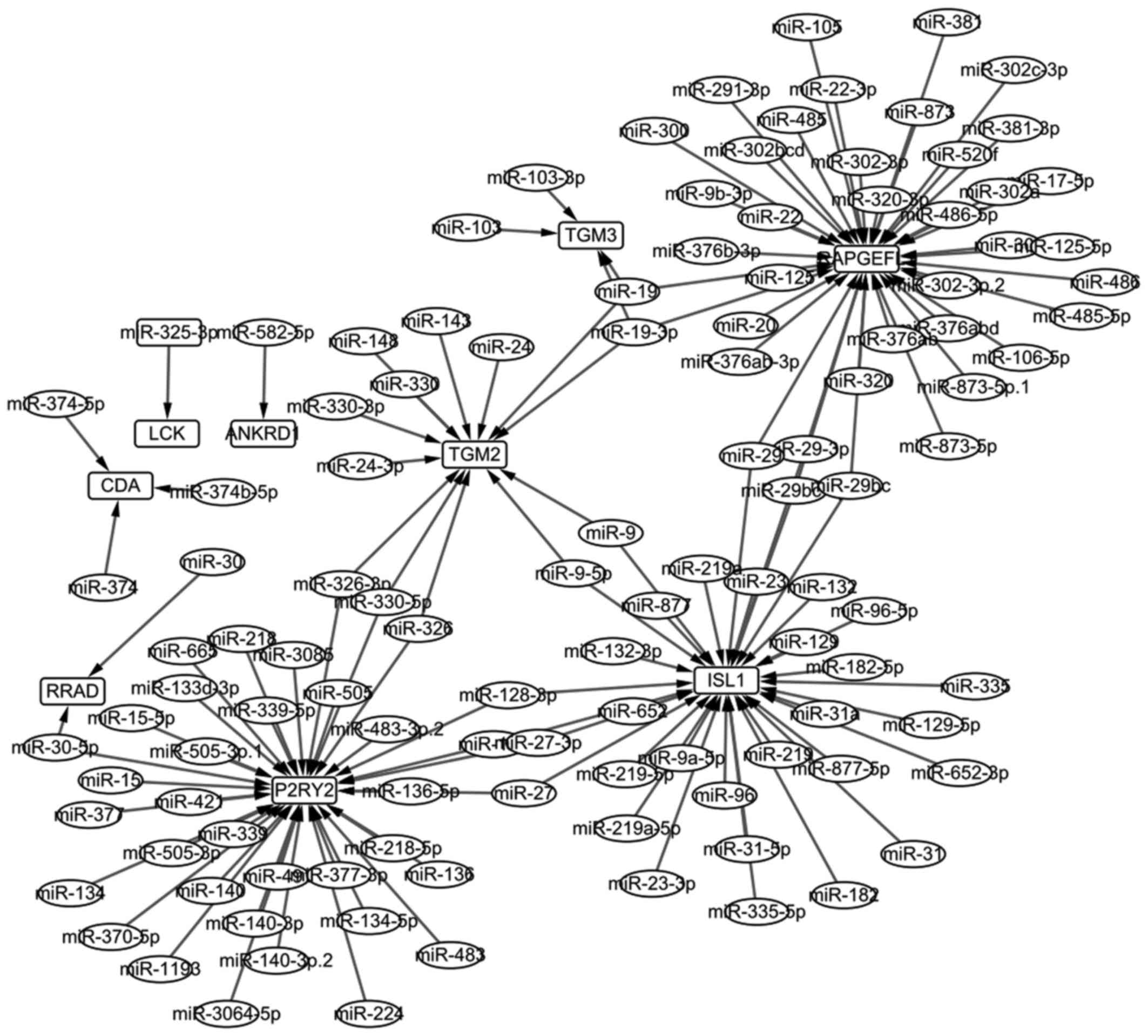|
1
|
Jemal A, Bray F, Center MM, Ferlay J, Ward
E and Forman D: Global cancer statistics. CA Cancer J Clin.
61:69–90. 2011. View Article : Google Scholar : PubMed/NCBI
|
|
2
|
Cao ZG and Li CZ: A single nucleotide
polymorphism in the matrix metalloproteinase-1 promoter enhances
oral squamous cell carcinoma susceptibility in a Chinese
population. Oral Oncol. 42:32–38. 2006. View Article : Google Scholar
|
|
3
|
Warnakulasuriya S: Living with oral
cancer: Epidemiology with particular reference to prevalence and
life-style changes that influence survival. Oral Oncol. 46:407–410.
2010. View Article : Google Scholar : PubMed/NCBI
|
|
4
|
Scully C and Bagan J: Oral squamous cell
carcinoma: Overview of current understanding of aetiopathogenesis
and clinical implications. Oral Dis. 15:388–399. 2009. View Article : Google Scholar : PubMed/NCBI
|
|
5
|
Ryu MH, Park HM, Chung J, Lee CH and Park
HR: Hypoxia-inducible factor-1alpha mediates oral squamous cell
carcinoma invasion via upregulation of alpha5 integrin and
fibronectin. Biochem Biophys Res Commun. 393:11–15. 2010.
View Article : Google Scholar : PubMed/NCBI
|
|
6
|
Severino P, Oliveira LS, Andreghetto FM,
Torres N, Curioni O, Cury PM, Toporcov TN, Paschoal AR and Durham
AM: Small RNAs in metastatic and non-metastatic oral squamous cell
carcinoma. BMC Med Genomics. 8:312015. View Article : Google Scholar : PubMed/NCBI
|
|
7
|
Zhang ZF, Morgenstern H, Spitz MR, Tashkin
DP, Yu GP, Hsu TC and Schantz SP: Environmental tobacco smoking,
mutagen sensitivity, and head and neck squamous cell carcinoma.
Cancer Epidemiol Biomarkers Prev. 9:1043–1049. 2000.PubMed/NCBI
|
|
8
|
Lewin F, Norell SE, Johansson H,
Gustavsson P, Wennerberg J, Biörklund A and Rutqvist LE: Smoking
tobacco, oral snuff, and alcohol in the etiology of squamous cell
carcinoma of the head and neck: A population-based case-referent
study in Sweden. Cancer. 82:1367–1375. 1998. View Article : Google Scholar : PubMed/NCBI
|
|
9
|
Binnie WH, Rankin KV and Mackenzie IC:
Etiology of oral squamous cell carcinoma. J Oral Pathol. 12:11–29.
1983. View Article : Google Scholar : PubMed/NCBI
|
|
10
|
Mehrotra R and Yadav S: Oral squamous cell
carcinoma: Etiology, pathogenesis and prognostic value of genomic
alterations. Indian J Cancer. 43:60–66. 2006. View Article : Google Scholar : PubMed/NCBI
|
|
11
|
Hsu TC, Spitz MR and Schantz SP: Mutagen
sensitivity: A biological marker of cancer susceptibility. Cancer
Epidemiol Biomarkers Prev. 1:83–89. 1991.PubMed/NCBI
|
|
12
|
Schantz SP, Zhang ZF, Spitz MS, Sun M and
Hsu TC: Genetic susceptibility to head and neck cancer: Interaction
between nutrition and mutagen sensitivity. Laryngoscope.
107:765–781. 1997. View Article : Google Scholar
|
|
13
|
Székely G, Remenár E, Kásler M and Gundy
S: Mutagen sensitivity of patients with cancer at different sites
of the head and neck. Mutagenesis. 20:381–385. 2005. View Article : Google Scholar : PubMed/NCBI
|
|
14
|
Walker DM, Boey G and McDonald LA: The
pathology of oral cancer. Pathology. 35:376–383. 2003. View Article : Google Scholar : PubMed/NCBI
|
|
15
|
O'Donnell RK, Kupferman M, Wei SJ, Singhal
S, Weber R, O'Malley B, Cheng Y, Putt M, Feldman M, Ziober B, et
al: Gene expression signature predicts lymphatic metastasis in
squamous cell carcinoma of the oral cavity. Oncogene. 24:1244–1251.
2005. View Article : Google Scholar
|
|
16
|
Manikandan M, Deva Magendhra Rao AK,
Arunkumar G, Manickavasagam M, Rajkumar KS, Rajaraman R and
Munirajan AK: Oral squamous cell carcinoma: microRNA expression
profiling and integrative analyses for elucidation of
tumourigenesis mechanism. Mol Cancer. 15:282016. View Article : Google Scholar : PubMed/NCBI
|
|
17
|
Gautier L, Cope L, Bolstad BM and Irizarry
RA: affy - analysis of Affymetrix GeneChip data at the probe level.
Bioinformatics. 20:307–315. 2004. View Article : Google Scholar : PubMed/NCBI
|
|
18
|
Diboun I, Wernisch L, Orengo CA and
Koltzenburg M: Microarray analysis after RNA amplification can
detect pronounced differences in gene expression using limma. BMC
Genomics. 7:2522006. View Article : Google Scholar : PubMed/NCBI
|
|
19
|
Sherman BT, Huang W, Tan Q, Guo Y, Bour S,
Liu D, Stephens R, Baseler MW, Lane HC and Lempicki RA: DAVID
Knowledgebase: A gene-centered database integrating heterogeneous
gene annotation resources to facilitate high-throughput gene
functional analysis. BMC Bioinformatics. 8:4262007. View Article : Google Scholar : PubMed/NCBI
|
|
20
|
Agarwal V, Bell GW, Nam JW and Bartel DP:
Predicting effective microRNA target sites in mammalian mRNAs.
eLife. 4:42015. View Article : Google Scholar
|
|
21
|
Shannon P, Markiel A, Ozier O, Baliga NS,
Wang JT, Ramage D, Amin N, Schwikowski B and Ideker T: Cytoscape: A
software environment for integrated models of biomolecular
interaction networks. Genome Res. 13:2498–2504. 2003. View Article : Google Scholar : PubMed/NCBI
|
|
22
|
Winder DM, Chattopadhyay A, Muralidhar B,
Bauer J, English WR, Zhang X, Karagavriilidou K, Roberts I, Pett
MR, Murphy G, et al: Overexpression of the oncostatin M receptor in
cervical squamous cell carcinoma cells is associated with a
pro-angiogenic phenotype and increased cell motility and
invasiveness. J Pathol. 225:448–462. 2011. View Article : Google Scholar : PubMed/NCBI
|
|
23
|
Wang Z and Griffin M: TG2, a novel
extracellular protein with multiple functions. Amino Acids.
42:939–949. 2012. View Article : Google Scholar
|
|
24
|
Mehta K, Kumar A and Kim HI:
Transglutaminase 2: A multitasking protein in the complex circuitry
of inflammation and cancer. Biochem Pharmacol. 80:1921–1929. 2010.
View Article : Google Scholar : PubMed/NCBI
|
|
25
|
Jung HJ, Chen Z, Wang M, Fayad L,
Romaguera J, Kwak LW and McCarty N: Calcium blockers decrease the
bortezomib resistance in mantle cell lymphoma via manipulation of
tissue transglutaminase activities. Blood. 119:2568–2578. 2012.
View Article : Google Scholar : PubMed/NCBI
|
|
26
|
Miyoshi N, Ishii H, Mimori K, Tanaka F,
Hitora T, Tei M, Sekimoto M, Doki Y and Mori M: TGM2 is a novel
marker for prognosis and therapeutic target in colorectal cancer.
Ann Surg Oncol. 17:967–972. 2010. View Article : Google Scholar
|
|
27
|
Guo T, Wang W, Zhang H, Liu Y, Chen P, Ma
K and Zhou C: ISL1 promotes pancreatic islet cell proliferation.
PLoS One. 6:e223872011. View Article : Google Scholar : PubMed/NCBI
|
|
28
|
Cheung IY, Feng Y, Gerald W and Cheung NK:
Exploiting gene expression profiling to identify novel minimal
residual disease markers of neuroblastoma. Clin Cancer Res.
14:7020–7027. 2008. View Article : Google Scholar : PubMed/NCBI
|
|
29
|
Schmitt AM, Riniker F, Anlauf M, Schmid S,
Soltermann A, Moch H, Heitz PU, Klöppel G, Komminoth P and Perren
A: Islet 1 (Isl1) expression is a reliable marker for pancreatic
endocrine tumors and their metastases. Am J Surg Pathol.
32:420–425. 2008. View Article : Google Scholar : PubMed/NCBI
|
|
30
|
Ogino H, Nishimura N, Kitamura A, Ishikawa
G, Okafuji K, Tomishima Y, Jinta T, Yamazoe M, Yang Y and
Chohnabayashi N: A patient with lung squamous cell carcinoma
presenting with severe cardiac dysfunction similar to dilated
cardiomyopathy with left bundle branch block induced by myocardial
metastasis. Intern Med. 53:2353–2357. 2014. View Article : Google Scholar : PubMed/NCBI
|
|
31
|
Takahashi T, Matsuda Y, Yamashita S,
Hattori N, Kushima R, Lee YC, Igaki H, Tachimori Y, Nagino M and
Ushijima T: Estimation of the fraction of cancer cells in a tumor
DNA sample using DNA methylation. PLoS One. 8:e823022013.
View Article : Google Scholar : PubMed/NCBI
|
|
32
|
Chen Y, Yin D, Li L, Deng YC and Tian W:
Screening aberrant methylation profile in esophageal squamous cell
carcinoma for Kazakhs in Xinjiang area of China. Mol Biol Rep.
42:457–464. 2015. View Article : Google Scholar
|
|
33
|
Fang WG, Pirnia F, Bang YJ, Myers CE and
Trepel JB: P2-purinergic receptor agonists inhibit the growth of
androgen-independent prostate carcinoma cells. J Clin Invest.
89:191–196. 1992. View Article : Google Scholar : PubMed/NCBI
|
|
34
|
Duncan G, Riach RA, Williams MR, Webb SF,
Dawson AP and Reddan JR: Calcium mobilisation modulates growth of
lens cells. Cell Calcium. 19:83–89. 1996. View Article : Google Scholar : PubMed/NCBI
|
|
35
|
McConkey DJ and Orrenius S: The role of
calcium in the regulation of apoptosis. Biochem Biophys Res Commun.
239:357–366. 1997. View Article : Google Scholar : PubMed/NCBI
|
|
36
|
Fredholm BB, Abbracchio MP, Burnstock G,
Daly JW, Harden TK, Jacobson KA, Leff P and Williams M:
Nomenclature and classification of purinoceptors. Pharmacol Rev.
46:143–156. 1994.PubMed/NCBI
|
|
37
|
Bronte V, Macino B, Zambon A, Rosato A,
Mandruzzato S, Zanovello P and Collavo D: Protein tyrosine kinases
and phosphatases control apoptosis induced by extracellular
adenosine 5′-triphosphate. Biochem Biophys Res Commun. 218:344–351.
1996. View Article : Google Scholar : PubMed/NCBI
|
|
38
|
Ishikawa S, Higashiyama M, Kusaka I and
Saito T, Nagasaka S, Fukuda S and Saito T: Extracellular ATP
promotes cellular growth of renal inner medullary collecting duct
cells mediated via P2u receptors. Nephron. 76:208–214. 1997.
View Article : Google Scholar : PubMed/NCBI
|
|
39
|
Maaser K, Höpfner M, Kap H, Sutter AP,
Barthel B, von Lampe B, Zeitz M and Scherübl H: Extracellular
nucleotides inhibit growth of human oesophageal cancer cells via
P2Y(2)-receptors. Br J Cancer. 86:636–644. 2002. View Article : Google Scholar : PubMed/NCBI
|













